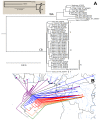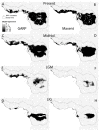A phylogeographic investigation of African monkeypox
- PMID: 25912718
- PMCID: PMC4411695
- DOI: 10.3390/v7042168
A phylogeographic investigation of African monkeypox
Abstract
Monkeypox is a zoonotic disease caused by a virus member of the genus Orthopoxvirus and is endemic to Central and Western African countries. Previous work has identified two geographically disjuct clades of monkeypox virus based on the analysis of a few genomes coupled with epidemiological and clinical analyses; however, environmental and geographic causes of this differentiation have not been explored. Here, we expand previous phylogenetic studies by analyzing a larger set of monkeypox virus genomes originating throughout Sub-Saharan Africa to identify possible biogeographic barriers associated with genetic differentiation; and projected ecological niche models onto environmental conditions at three periods in the past to explore the potential role of climate oscillations in the evolution of the two primary clades. Analyses supported the separation of the Congo Basin and West Africa clades; the Congo Basin clade shows much shorter branches, which likely indicate a more recent diversification of isolates within this clade. The area between the Sanaga and Cross Rivers divides the two clades and the Dahomey Gap seems to have also served as a barrier within the West African clade. Contraction of areas with suitable environments for monkeypox virus during the Last Glacial Maximum, suggests that the Congo Basin clade of monkeypox virus experienced a severe bottleneck and has since expanded its geographic range.
Figures



References
Publication types
MeSH terms
Substances
Associated data
- Actions
- Actions
- Actions
- Actions
- Actions
- Actions
- Actions
- Actions
- Actions
- Actions
- Actions
LinkOut - more resources
Full Text Sources
Other Literature Sources
Medical
Miscellaneous

